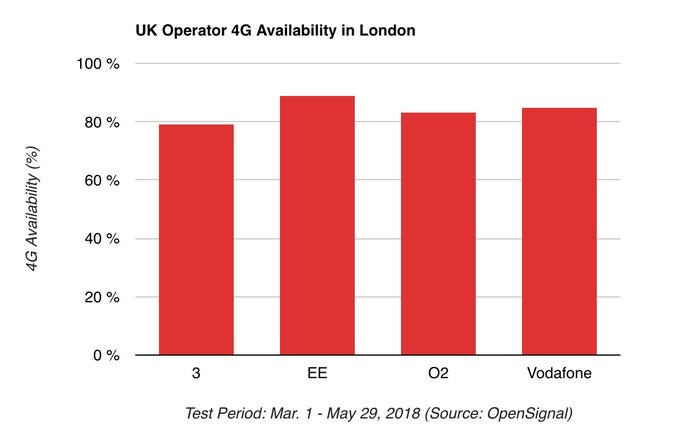Can we ever hope to eliminate mobile notspots in London?
The elimination of notspots is a commendable goal – but unfortunately, it's not a very realistic one.
July 18, 2018

Telecoms.com periodically invites third parties to share their views on the industry’s most pressing issues. In this piece Brendan Gill, Co-founder and CEO of OpenSignal looks at the state of London’s mobile notspots and what can be done about them.
This summer we’ve seen the launch of the ambitious Connected London programme, which hopes to drive improvement in the UK’s capital through digital technology and data. This includes tackling mobile broadband “notspots” – where a mobile network connection is absent or extremely weak or patchy. But even in the best-served metropolitan regions, can mobile operators ever hope to achieve 100 percent connectivity?
The elimination of notspots is a commendable goal – but unfortunately, it’s not a very realistic one. Notspots will never go away completely as they’re part of the nature of building cellular networks. We believe it’s unlikely any operator will ever achieve this goal, or even reach 99 percent network coverage in urban areas. The ‘holy grail’ score of 100 percent connectivity may be just that – a myth.
There are a variety of reasons why notspots occur in mobile network coverage of urban areas. These fall into four broad areas:
Places where operators offer no coverage. This is what everyone thinks of as a notspot. For business or logistical reasons operators simply don’t extend their networks to cover particular areas. An urban-focused operator may not offer services in smaller towns and villages, or there may be obstacles to infrastructure rollout such as planning permission.
Dead zones created by network interference on the edges of cells. These are especially prevalent in urban areas, where cell towers are crowded closer together and the ‘borders’ are harder to anticipate and mitigate due to high buildings and other obstacles.
In-building dead zones where signals can’t penetrate, for instance elevators and basements. This problem is obviously magnified in an urban region, and is increasing as higher-bandwidth spectrum with poorer building-penetration capabilities are sold for mobile use.
Temporary notspots generated when the network becomes too congested, and customers are shunted down to 3G or 2G, or disconnected completely. This occurs when data demand simply exceeds network capacity.
Operators can do a lot to mitigate each of these issues, such as deploying small cells or repurposing lower frequency spectrum from 2G, but some problems will always persist. When you consider the number of factors that can cause mobile coverage notspots, added to the increased use of higher bandwidths for mobile (which can help operators increase network capacity, but offer lower propagation) and ramping consumer data demand, notspots can never ever be completely eliminated.
OpenSignal’s 4G availability metric measures the proportion of time users with a 4G device and subscription are able to get an LTE connection. As such we can use this as an indicator of how far an operator has come toward eliminating notspots on their 4G networks. To illustrate how close the U.K.’s operators have come to that goal, we’ve taken a look at how the U.K.’s four national operators performed in London in 4G availability. EE scored the highest in the capital with LTE reach of nearly 89 percent in our measurements, while all four players were over 79 percent. That means London still has plenty of notspots on its 4G networks.
 But London isn’t the only city with 4G notspot problems. South Korea topped our 4G availability metric in our most recent global State of LTE report, and came fourth of 88 countries for 4G download speed, making it arguably the most advanced 4G market in the world. But the global leader in LTE reach scored 97.5 percent in our 4G availability metric, while the capital Seoul reached 97.9 percent – two percent off the 100 percent mark. As 4G networks mature and operator focus begins to shift to 5G and beyond, it’s probable that we’ll have to continue to contend with notspots, even in the world’s most connected cities.
But London isn’t the only city with 4G notspot problems. South Korea topped our 4G availability metric in our most recent global State of LTE report, and came fourth of 88 countries for 4G download speed, making it arguably the most advanced 4G market in the world. But the global leader in LTE reach scored 97.5 percent in our 4G availability metric, while the capital Seoul reached 97.9 percent – two percent off the 100 percent mark. As 4G networks mature and operator focus begins to shift to 5G and beyond, it’s probable that we’ll have to continue to contend with notspots, even in the world’s most connected cities.
 Brendan Gill is co-founder and CEO of OpenSignal, a mobile analytics company that measures users’ real-world mobile experience by analyzing billions of measurements from smartphones worldwide. OpenSignal believe seeing how the network performs directly through users’ eyes is the key to building better wireless networks. OpenSignal’s insights are used across the industry by mobile network operators, regulators and analysts. Download the OpenSignal app on Google Play and the App Store.
Brendan Gill is co-founder and CEO of OpenSignal, a mobile analytics company that measures users’ real-world mobile experience by analyzing billions of measurements from smartphones worldwide. OpenSignal believe seeing how the network performs directly through users’ eyes is the key to building better wireless networks. OpenSignal’s insights are used across the industry by mobile network operators, regulators and analysts. Download the OpenSignal app on Google Play and the App Store.
Read more about:
DiscussionAbout the Author(s)
You May Also Like











_1.jpg?width=700&auto=webp&quality=80&disable=upscale)


.png?width=800&auto=webp&quality=80&disable=upscale)